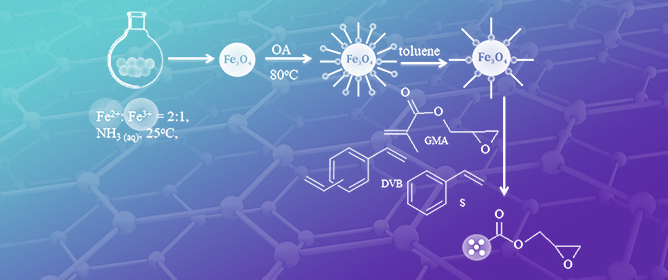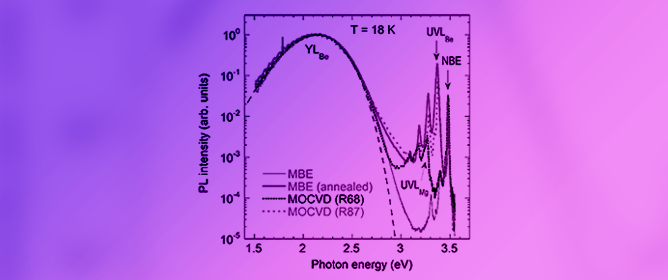Journal Description
Solids
Solids
is an international, peer-reviewed, open access journal on all areas of solid-state sciences published quarterly online by MDPI.
- Open Access— free for readers, with article processing charges (APC) paid by authors or their institutions.
- High Visibility: indexed within ESCI (Web of Science), Scopus, EBSCO, CAPlus / SciFinder, and other databases.
- Rapid Publication: manuscripts are peer-reviewed and a first decision is provided to authors approximately 17.5 days after submission; acceptance to publication is undertaken in 12.9 days (median values for papers published in this journal in the second half of 2023).
- Recognition of Reviewers: APC discount vouchers, optional signed peer review, and reviewer names published annually in the journal.
Latest Articles
Advanced Prussian Blue Cathodes for Rechargeable Li-Ion Batteries
Solids 2024, 5(2), 208-226; https://doi.org/10.3390/solids5020014 - 16 Apr 2024
Abstract
►
Show Figures
Taking advantage of fact that the surface electrons of metallic nanoparticles (NPs) can be effectively released even at a low voltage bias, we demonstrate an improvement in the electrochemical performance of nanosized Prussian Blue (PB)-based secondary batteries through the incorporation of bare Ag
[...] Read more.
Taking advantage of fact that the surface electrons of metallic nanoparticles (NPs) can be effectively released even at a low voltage bias, we demonstrate an improvement in the electrochemical performance of nanosized Prussian Blue (PB)-based secondary batteries through the incorporation of bare Ag or Ni NPs in the vicinity of the working PB NPs. It is found that the capacity for electrochemical energy storage of the 17 nm PB-based battery is significantly higher than the capacity of 10 nm PB-based, 35 nm PB-based or 46 nm PB-based batteries. There is a critical PB size for the highest electrochemical energy storage efficiency. The full specific capacity CF of the 17 nm PB-based battery stabilized to 62 mAh/g after 130 charge–discharge cycles at a working current of IW = 0.03 mA. The addition of 14 mass percent of Ag NPs in the vicinity of the PB NPs gave rise to a 32% increase in the stabilized CF. A 42% increase in the stabilized CF could be obtained with the addition of 14 mass percent of Ag NPs on the working electrode of the 35 nm PB-based battery. An enhancement in CF was also found for electrodes incorporating bare Ni NPs but the effect was smaller.
Full article
Open AccessArticle
Charge Critical Phenomena in a Field Heterostructure with Two-Dimensional Crystal
by
Alexander L. Danilyuk, Denis A. Podryabinkin, Victor L. Shaposhnikov and Serghej L. Prischepa
Solids 2024, 5(2), 193-207; https://doi.org/10.3390/solids5020013 - 06 Apr 2024
Abstract
►▼
Show Figures
The charge properties and regularities of mutual influence of the electro-physical parameters in a metal (M)/insulator (I)/two-dimensional crystal heterostructure were studied. In one case, the transition metal dichalcogenide (TMD) MoS2 was considered as a two-dimensional crystal, and in another the Weyl semi-metal
[...] Read more.
The charge properties and regularities of mutual influence of the electro-physical parameters in a metal (M)/insulator (I)/two-dimensional crystal heterostructure were studied. In one case, the transition metal dichalcogenide (TMD) MoS2 was considered as a two-dimensional crystal, and in another the Weyl semi-metal (WSM) ZrTe5, representative of a quasi-two-dimensional crystal was chosen for this purpose. By self-consistently solving the electrostatic equations of the heterostructures under consideration and the Fermi–Dirac distribution, the relationship between such parameters as the concentration of charge carriers, chemical potential, and quantum capacitance of the TMD (WSM), as well as the capacitance of the I layer and the interface capacitance I–TMD (WSM), and their dependence on the field electrode potential, have been derived. The conditions for the emergence of charge instability and the critical phenomena caused by it are also determined.
Full article
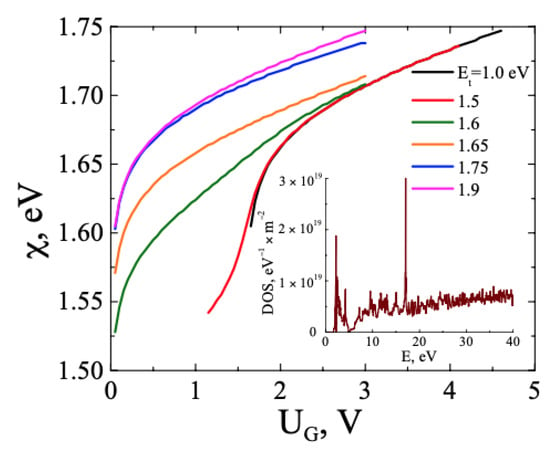
Figure 1
Open AccessFeature PaperArticle
A Comparative Study on the Choice of the Support in the Elaboration of Photocatalysts for the Photooxidation of Benzyl Alcohol under Mild Conditions
by
Lénaïck Hervé, Svetlana Heyte, Maya Marinova, Sébastien Paul, Robert Wojcieszak and Joëlle Thuriot-Roukos
Solids 2024, 5(2), 172-192; https://doi.org/10.3390/solids5020012 - 01 Apr 2024
Abstract
►▼
Show Figures
In the quest to combat global warming, traditional thermal chemistry processes are giving way to selective photocatalysis, an eco-friendly approach that operates under milder conditions, using benign solvents like water. Benzaldehyde, a versatile compound with applications spanning agroindustry, pharmaceuticals, and cosmetics, serves as
[...] Read more.
In the quest to combat global warming, traditional thermal chemistry processes are giving way to selective photocatalysis, an eco-friendly approach that operates under milder conditions, using benign solvents like water. Benzaldehyde, a versatile compound with applications spanning agroindustry, pharmaceuticals, and cosmetics, serves as a fundamental building block for various fine chemicals. This study aims at enhancing benzaldehyde production sustainability by utilizing photooxidation of benzyl alcohol. Gold nanoparticle-based catalysts are renowned for their exceptional efficiency in oxidizing bio-based molecules. In this research, Au nanoparticles were anchored onto three distinct supports:

Figure 1
Open AccessFeature PaperArticle
Reactive Polymer Composite Microparticles Based on Glycidyl Methacrylate and Magnetite Nanoparticles
by
Agnieszka Bukowska, Karol Bester, Sylwia Flaga and Wiktor Bukowski
Solids 2024, 5(1), 151-171; https://doi.org/10.3390/solids5010011 - 18 Mar 2024
Abstract
►▼
Show Figures
The modified suspension polymerization technique has been used for the preparation of composite microparticles from the mixture of glycidyl methacrylate (GMA), styrene (S), and divinylbenzene (DVB) in the presence of hydrophobized Fe3O4 nanoparticles. The obtained polymer microspheres were characterized using
[...] Read more.
The modified suspension polymerization technique has been used for the preparation of composite microparticles from the mixture of glycidyl methacrylate (GMA), styrene (S), and divinylbenzene (DVB) in the presence of hydrophobized Fe3O4 nanoparticles. The obtained polymer microspheres were characterized using different instrumental and physicochemical techniques, modified with a zero-order PAMAM dendrimer, and impregnated with palladium(II) acetate solutions to immobilize palladium(II) ions. The resulting materials were preliminarily examined as catalysts in the Suzuki reaction between 4-bromotoluene and phenylboronic acid. It was found that the addition of magnetite particles to the composition of monomers provided polymer microparticles with embedded magnetic nanoparticles. The composite microparticles obtained showed a complex, multi-hollow, or raspberry-like morphology. After their modification, they could serve as recyclable catalysts for reactions that include both 4-bromotoluene and several other aryl bromides.
Full article

Figure 1
Open AccessArticle
Direct Synthesis of CuP2 and Cu3P and Their Performance as Electrocatalysts for Hydrogen Evolution, Oxygen Evolution, and Oxygen Reduction Reactions
by
Xiao Ma, Xueni Huang and Abdessadek Lachgar
Solids 2024, 5(1), 140-150; https://doi.org/10.3390/solids5010010 - 07 Mar 2024
Abstract
►▼
Show Figures
Copper phosphides are promising materials for energy conversion applications because of their unique electronic structure and controllable composition. Two stoichiometric copper phosphides, CuP2 and Cu3P, were prepared by direct wet-chemical synthesis using red phosphorus. They were characterized by powder X-ray
[...] Read more.
Copper phosphides are promising materials for energy conversion applications because of their unique electronic structure and controllable composition. Two stoichiometric copper phosphides, CuP2 and Cu3P, were prepared by direct wet-chemical synthesis using red phosphorus. They were characterized by powder X-ray diffraction, scanning and transmission electron microscopy, and X-ray photoelectron spectroscopy. The precursor selection, reaction temperature, time and solvent composition were also studied. CuP2 is the thermodynamically more stable product, but Cu3P is more commonly obtained. This work demonstrated that higher temperature helps in CuP2 formation. More importantly, using more trioctylphosphine oxide helps control the morphology leading to crystal growth along the crystallographic a-axis. CuP2 and Cu3P were tested for hydrogen evolution, oxygen evolution, and oxygen reduction reactions. CuP2 works better for HER in acidic conditions and OER in general, and Cu3P showed better activity than CuP2 for HER and ORR in an alkaline medium. This study has led to a simple approach to the synthesis of CuP2 nanowires.
Full article

Graphical abstract
Open AccessArticle
Microstructure-Based CZE Model for Crack Initiation and Growth in CGI: Effects of Graphite-Particle Morphology and Spacing
by
Xingling Luo, Konstantinos P. Baxevanakis and Vadim V. Silberschmidt
Solids 2024, 5(1), 123-139; https://doi.org/10.3390/solids5010009 - 01 Mar 2024
Abstract
►▼
Show Figures
Compacted graphite iron (CGI) is an engineering material with the potential to fill the application gap between flake- and spheroidal-graphite irons thanks to its unique microstructure and competitive price. Despite its wide use and considerable past research, its complex microstructure often leads researchers
[...] Read more.
Compacted graphite iron (CGI) is an engineering material with the potential to fill the application gap between flake- and spheroidal-graphite irons thanks to its unique microstructure and competitive price. Despite its wide use and considerable past research, its complex microstructure often leads researchers to focus on models based on representative volume elements with multiple particles, frequently overlooking the impact of individual particle shapes and interactions between the neighbouring particles on crack initiation and propagation. This study focuses on the effects of graphite morphology and spacing between inclusions on the mechanical and fracture behaviours of CGI at the microscale. In this work, 2D cohesive-zone-element-based models with different graphite morphologies and spacings were developed to investigate the mechanical behaviour as well as crack initiation and propagation. ImageJ and scanning electron microscopy were used to characterise and analyse the microstructure of CGI. In simulations, both graphite particles and metallic matrix were assumed isotropic and ductile. Cohesive zone elements (CZEs) were employed in the whole domain studied. It was found that graphite morphology had a negligible effect on interface debonding but nodular inclusions can notably enhance the stiffness of the material and effectively impede the propagation of cracks within the matrix. Besides, a small distance between graphite particles accelerates the crack growth. These results can be used to design and manufacture better metal-matrix composites.
Full article

Graphical abstract
Open AccessArticle
Uncovering the Effects of Non-Hydrostaticity on Pressure-Induced Phase Transformation in Xenotime-Structured TbPO4
by
Jai Sharma and Corinne E. Packard
Solids 2024, 5(1), 110-122; https://doi.org/10.3390/solids5010008 - 16 Feb 2024
Abstract
The pressure-induced phase transformations of rare earth orthophosphates (REPO4s) have become increasingly relevant in ceramic matrix composite (CMC) research; however, understanding of the shear-dependence of these transformations remains limited. This study employs diamond anvil cell experiments with three pressure media (neon,
[...] Read more.
The pressure-induced phase transformations of rare earth orthophosphates (REPO4s) have become increasingly relevant in ceramic matrix composite (CMC) research; however, understanding of the shear-dependence of these transformations remains limited. This study employs diamond anvil cell experiments with three pressure media (neon, KCl, sample itself/no medium) to systematically assess the effect of shear on the phase transformations of TbPO4. Results show a lowering of the TbPO4 transformation onset pressure (Ponset) as well as an extension of the xenotime–monazite phase coexistence range under non-hydrostatic conditions. The TbPO4 Ponset under no medium (4.4(3) GPa) is the lowest REPO4 Ponset reported to date and represents a ~50% drop from the hydrostatic Ponset. Enthalpic differences likely account for lower Ponset values in TbPO4 compared to DyPO4. Experiments also show scheelite may be the post-monazite phase of TbPO4; this phase is consistent with observed and predicted REPO4 transformation pathways.
Full article
(This article belongs to the Special Issue A Themed Issue in Honour of Professor Alexandra Navrotsky on the Occasion of Her 80th Birthday)
►▼
Show Figures

Graphical abstract
Open AccessArticle
Luminous Transmittance and Color Rendering Characteristics of Evaporated Chalcopyrite Thin Films for Semitransparent Photovoltaics
by
Cecilia Guillén
Solids 2024, 5(1), 98-109; https://doi.org/10.3390/solids5010007 - 08 Feb 2024
Abstract
►▼
Show Figures
The luminous transmittance and the color rendering index of daylight through semitransparent photovoltaic glazing are essential parameters for visual comfort indoors, and they must be considered for different absorber materials that were traditionally developed for opaque solar cells, such as those of the
[...] Read more.
The luminous transmittance and the color rendering index of daylight through semitransparent photovoltaic glazing are essential parameters for visual comfort indoors, and they must be considered for different absorber materials that were traditionally developed for opaque solar cells, such as those of the chalcopyrite type. With this aim, various chalcopyrite compounds (CuInSe2, CuInS2 and CuGaS2) were prepared by means of evaporation and then measured to obtain their optical absorption spectra. These experimental data are used here to calculate the solar absorptance (αS), luminous transmittance (τL) and color rendering index (Ra) as a function of the chalcopyrite film thickness. The comparative analysis of the different factors indicates that 70 nm thick CuInSe2 is optimal to guarantee excellent visual comfort (τL = 50% and Ra = 93%) while absorbing as much solar irradiance (αS = 37%) as 130 nm thick CuInS2 or 900 nm thick CuGaS2. The second option (130 nm thick CuInS2) is also considered good (τL = 40% and Ra = 80%), but for CuGaS2, the thickness should be kept below 250 nm in order to obtain a suitable color rendering Ra ≥ 60%.
Full article
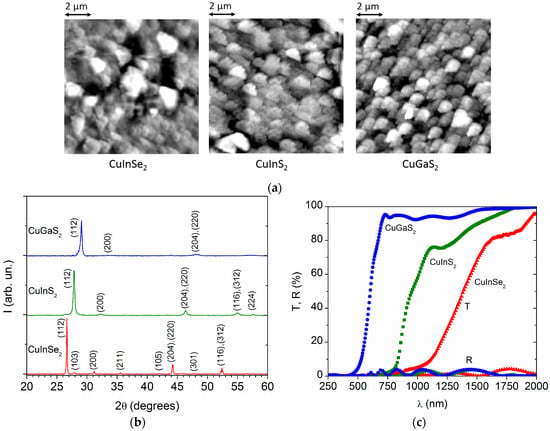
Figure 1
Open AccessArticle
Durability Prediction of Cyclically Loaded CP-W800 Fillet Welds
by
Dejan Tomažinčič, Peter Zobec, Marko Vrh, Aleš Gosar, Jurij Švegelj, Matic Muc, Vili Malnarič, Jernej Klemenc and Domen Šeruga
Solids 2024, 5(1), 84-97; https://doi.org/10.3390/solids5010006 - 01 Feb 2024
Abstract
►▼
Show Figures
Two methods of durability prediction of fillet welds were researched in this study. Namely, the structural Hot-Spot method and the structural stress method fe-safe Verity were applied to fatigue life estimation of a double plate lap fillet weld made of high-strength complex phase
[...] Read more.
Two methods of durability prediction of fillet welds were researched in this study. Namely, the structural Hot-Spot method and the structural stress method fe-safe Verity were applied to fatigue life estimation of a double plate lap fillet weld made of high-strength complex phase CP-W800 steel. Durability predictions were compared against available high-cycle fatigue experimental data obtained for the same weld detail and material. Both 2D and 3D finite element meshes were considered in the simulations. It was shown that comparable predictions were obtained using either the Hot-Spot method or the fe-safe Verity module in the case of the 3D FE mesh. On the contrary, a less conservative durability prediction was observed using the Hot-Spot method and a more conservative durability prediction was gained using the fe-safe Verity module in the case of the 2D FE mesh due to a different consideration of stress concentration around the weld.
Full article

Figure 1
Open AccessArticle
Microwave Absorption Properties of Ceramics Based on BiFeO3 Modified with Ho
by
Pavel Astafev, Konstantin Andryushin, Aleksey Pavelko, Alexander Lerer, Yakov Reizenkind, Ekaterina Glazunova, Lidiya Shilkina, Inna Andryushina, Alexandr Nagaenko and Larisa Reznichenko
Solids 2024, 5(1), 66-83; https://doi.org/10.3390/solids5010005 - 17 Jan 2024
Abstract
►▼
Show Figures
Ceramic samples of Bi1−xHoxFeO3, where x = 0.00–0.50, with a modifier concentration variation step ∆x = 0.05–0.10, were prepared by a two-step solid-phase synthesis followed by sintering using conventional ceramic technology. X-ray phase analysis showed
[...] Read more.
Ceramic samples of Bi1−xHoxFeO3, where x = 0.00–0.50, with a modifier concentration variation step ∆x = 0.05–0.10, were prepared by a two-step solid-phase synthesis followed by sintering using conventional ceramic technology. X-ray phase analysis showed that all the solid solutions studied were formed in the presence of impurities. With increasing Ho concentration, a non-monotonic shift in all loss maxima towards the low-frequency region is observed, as well as an increase in their half-width. An increase in the external temperature leads to a monotonic shift in the absorption maxima towards the low-frequency region, which enables the necessary control of the microwave parameters in the X band. A conclusion has been drawn on the feasibility of using the data obtained in the design of new functional materials based on BiFeO3, as well as devices with thermally controlled frequency.
Full article

Figure 1
Open AccessFeature PaperReview
Two-Dimensional Ferroelectrics: A Review on Applications and Devices
by
Gabriella Maria De Luca and Andrea Rubano
Solids 2024, 5(1), 45-65; https://doi.org/10.3390/solids5010004 - 16 Jan 2024
Abstract
Over the last few years, research activities have seen two-dimensional (2D) materials become protagonists in the field of nanotechnology. In particular, 2D materials characterized by ferroelectric properties are extremely interesting, as they are better suited for the development of miniaturized and high-performing devices.
[...] Read more.
Over the last few years, research activities have seen two-dimensional (2D) materials become protagonists in the field of nanotechnology. In particular, 2D materials characterized by ferroelectric properties are extremely interesting, as they are better suited for the development of miniaturized and high-performing devices. Here, we summarize the recent advances in this field, reviewing the realization of devices based on 2D ferroelectric materials, like FeFET, FTJ, and optoelectronics. The devices are realized with a wide range of material systems, from oxide materials at low dimensions to 2D materials exhibiting van der Waals interactions. We conclude by presenting how these materials could be useful in the field of devices based on magnons or surface acoustic waves.
Full article
(This article belongs to the Special Issue Recent Advance in Ferroelectric Composites)
►▼
Show Figures
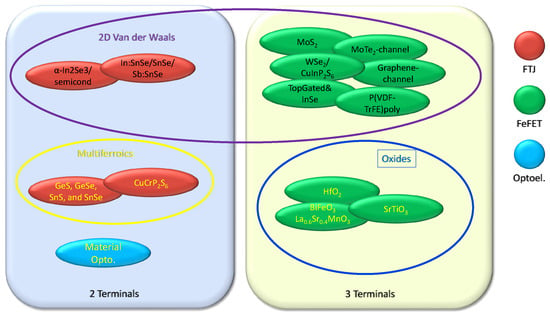
Figure 1
Open AccessFeature PaperArticle
The Origin of the Yellow Luminescence Band in Be-Doped Bulk GaN
by
Michael A. Reshchikov and Michal Bockowski
Solids 2024, 5(1), 29-44; https://doi.org/10.3390/solids5010003 - 04 Jan 2024
Abstract
►▼
Show Figures
Photoluminescence (PL) from Be-doped bulk GaN crystals grown by the High Nitrogen Pressure Solution method was studied and compared with PL from GaN:Be layers on sapphire grown by molecular beam epitaxy and metalorganic chemical vapor deposition techniques. The yellow luminescence band in the
[...] Read more.
Photoluminescence (PL) from Be-doped bulk GaN crystals grown by the High Nitrogen Pressure Solution method was studied and compared with PL from GaN:Be layers on sapphire grown by molecular beam epitaxy and metalorganic chemical vapor deposition techniques. The yellow luminescence band in the latter is caused by the isolated BeGa acceptor (the YLBe band), while the broad yellow band in bulk GaN:Be crystals is a superposition of the YLBe band and another band, most likely the CN-related YL1 band. The attribution of the yellow band in bulk GaN:Be crystals to the BeGaON complex (a deep donor) is questioned.
Full article
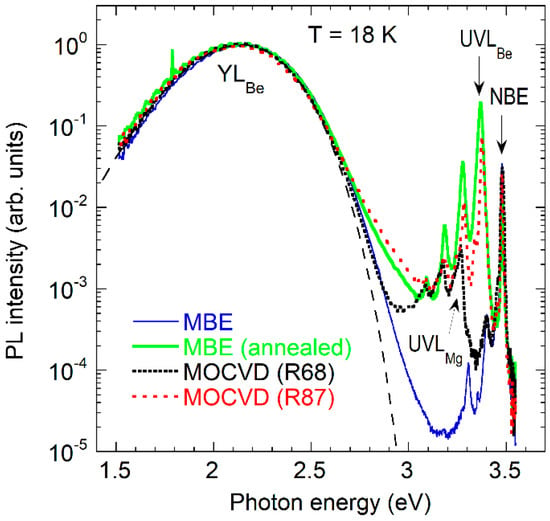
Figure 1
Open AccessArticle
Elastic Stress Field beneath a Sticking Circular Contact under Tangential Load
by
Emanuel Willert
Solids 2024, 5(1), 14-28; https://doi.org/10.3390/solids5010002 - 26 Dec 2023
Cited by 1
Abstract
►▼
Show Figures
Based on a potential theoretical approach, the subsurface stress field is calculated for an elastic half-space which is subject to normal and uniaxial tangential surface tractions that—in the case of elastic decoupling—correspond to rigid normal and tangential translations of a circular surface domain.
[...] Read more.
Based on a potential theoretical approach, the subsurface stress field is calculated for an elastic half-space which is subject to normal and uniaxial tangential surface tractions that—in the case of elastic decoupling—correspond to rigid normal and tangential translations of a circular surface domain. The stress fields are obtained explicitly and in closed form as the imaginary parts of compact complex-valued expressions. The stress state in the surface and on the central axis are considered in detail. As, within specific approximations that have been discussed at length in the literature, any tangential contact problem with friction can be understood as a certain incremental series of such rigid translations, the solutions presented here can serve as the basis of very fast superposition algorithms for the analysis of subsurface stress fields in general tangential contact problems with friction. This idea is demonstrated by means of the frictional tangential contact between an elastic half-space and a rigid cylindrical flat punch with rounded corners.
Full article

Graphical abstract
Open AccessArticle
Surface Characterization and Bulk Property Analysis of Aluminum Powders Treated with Hydrophobic Coatings: Stearic Acid and Phenyl-Phosphonic Acid
by
Bellamarie Ludwig
Solids 2024, 5(1), 1-13; https://doi.org/10.3390/solids5010001 - 22 Dec 2023
Abstract
►▼
Show Figures
Stearic and phenyl-phosphonic acids were applied to fine aluminum particles to understand their effect on the surface chemical composition and bulk properties of the surface-treated powders. During the solution phase deposition process, the surface composition changes chemically through a condensation reaction between the
[...] Read more.
Stearic and phenyl-phosphonic acids were applied to fine aluminum particles to understand their effect on the surface chemical composition and bulk properties of the surface-treated powders. During the solution phase deposition process, the surface composition changes chemically through a condensation reaction between the acid and particle surface hydroxyl groups, forming covalent chemical bonds. The retention of both types of acids was verified through characterization using Fourier transform infrared spectroscopy (FTIR) and X-ray photoelectron spectroscopy (XPS). The presence of stearic acid on the particle surface was observed through signature absorbance peaks, including interfacial C-O bonding modes, carboxylate, and carbonyl moieties, all present on both the treated powder. Spectra using XPS showed an increase in -CH relative intensity signal on the particle surface when compared to the raw material when considering the the carbon 2p photoelectron peak. Similar findings confirmed the presence of the phenyl-phosphonic acid when comparing to the raw material. The IR spectrum confirmed the presence of P-O-Al, P-O, and phosponates as a result of the surface bonding between the reagent and particles. XPS always provided evidence through the presence of phosphorous 2p and 2s photoelecton peaks at 191.3 and 133.4 eV, respectively. The bulk properties of both surface treated powders improved, as shown through improved apparent/tap density and a decreased Hausner Ratio (Group C to Group A behavior). Rheological characterization provided additional evidence by showing a reduced specific energy, flow rate index, and cohesion. The particle packing was improved as evidenced through reduced compressibility as a function of applied normal stress.
Full article
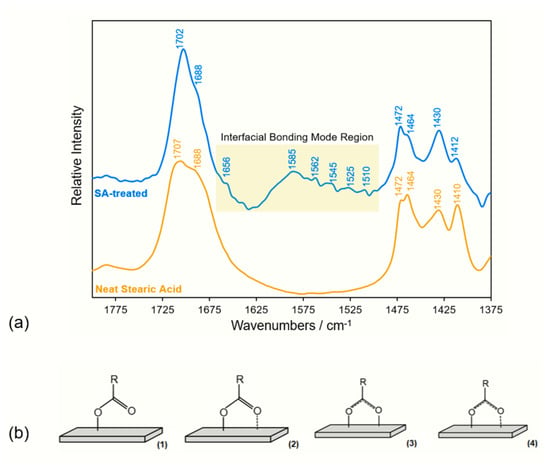
Figure 1
Open AccessArticle
A Comparative Study of n- and p-Channel FeFETs with Ferroelectric HZO Gate Dielectric
by
Paul Jacob, Pooja C. Patil, Shan Deng, Kai Ni, Khushwant Sehra, Mridula Gupta, Manoj Saxena, David MacMahon and Santosh Kurinec
Solids 2023, 4(4), 356-367; https://doi.org/10.3390/solids4040023 - 01 Dec 2023
Abstract
This study investigates the electrical characteristics observed in n-channel and p-channel ferroelectric field effect transistor (FeFET) devices fabricated through a similar process flow with 10 nm of ferroelectric hafnium zirconium oxide (HZO) as the gate dielectric. The n-FeFETs demonstrate a faster complete polarization
[...] Read more.
This study investigates the electrical characteristics observed in n-channel and p-channel ferroelectric field effect transistor (FeFET) devices fabricated through a similar process flow with 10 nm of ferroelectric hafnium zirconium oxide (HZO) as the gate dielectric. The n-FeFETs demonstrate a faster complete polarization switching compared to the p-channel counterparts. Detailed and systematic investigations using TCAD simulations reveal the role of fixed charges and interface traps at the HZO-interfacial layer (HZO/IL) interface in modulating the subthreshold characteristics of the devices. A characteristic crossover point observed in the transfer characteristics of n-channel devices is attributed with the temporary switching between ferroelectric-based operation to charge-based operation, caused by the pinning effect due to the presence of different traps. This experimental study helps understand the role of charge trapping effects in switching characteristics of n- and p-channel ferroelectric FETs.
Full article
(This article belongs to the Special Issue Recent Advance in Ferroelectric Composites)
►▼
Show Figures

Figure 1
Open AccessArticle
Synthesis and Crystal and Electronic Structures of the Zintl Phase Sr21Cd4Sb18
by
Kowsik Ghosh and Svilen Bobev
Solids 2023, 4(4), 344-355; https://doi.org/10.3390/solids4040022 - 17 Nov 2023
Abstract
Reported herein are the synthesis and crystal chemistry analysis of the Zintl phase Sr21Cd4Sb18. Single crystals of this compound were grown using the Sn-flux method, and structural characterization was carried out using single-crystal X-ray diffraction. Crystal data:
[...] Read more.
Reported herein are the synthesis and crystal chemistry analysis of the Zintl phase Sr21Cd4Sb18. Single crystals of this compound were grown using the Sn-flux method, and structural characterization was carried out using single-crystal X-ray diffraction. Crystal data: Monoclinic space group C2/m (No. 12, Z = 4); a = 18.2536(6) Å, b = 17.4018(5) Å, and c = 17.8979(6) Å, β = 92.024(1)°. The structure is based on edge- and corner-shared CdSb4 tetrahedra, which ultimately form octameric [Cd8Sb22] fragments, where two symmetry-equivalent subunits are connected via a homoatomic Sb–Sb interaction. The electronic band structure calculations contained herein reveal the emergence of a direct gap between the valence and the conduction bands.
Full article
(This article belongs to the Special Issue A Themed Issue in Honour of Professor Alexandra Navrotsky on the Occasion of Her 80th Birthday)
►▼
Show Figures
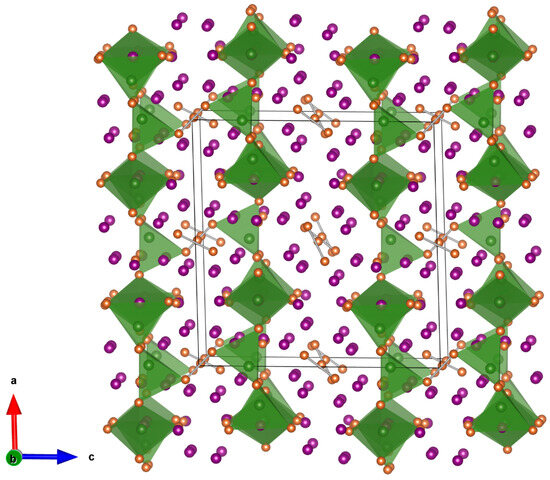
Figure 1
Open AccessArticle
Thermodynamic Properties as a Function of Temperature of AlMoNbV, NbTaTiV, NbTaTiZr, AlNbTaTiV, HfNbTaTiZr, and MoNbTaVW Refractory High-Entropy Alloys from First-Principles Calculations
by
Danielsen E. Moreno and Chelsey Z. Hargather
Solids 2023, 4(4), 327-343; https://doi.org/10.3390/solids4040021 - 06 Nov 2023
Abstract
Refractory high-entropy alloys (RHEAs) are strong candidates for use in high-temperature engineering applications. As such, the thermodynamic properties as a function of temperature for a variety of RHEA systems need to be studied. In the present work, thermodynamic quantities such as entropy, enthalpy,
[...] Read more.
Refractory high-entropy alloys (RHEAs) are strong candidates for use in high-temperature engineering applications. As such, the thermodynamic properties as a function of temperature for a variety of RHEA systems need to be studied. In the present work, thermodynamic quantities such as entropy, enthalpy, heat capacity at constant volume, and linear thermal expansion are calculated for three quaternary and three quinary single-phase, BCC RHEAs: AlMoNbV, NbTaTiV, NbTaTiZr, AlNbTaTiV, HfNbTaTiZr, and MoNbTaVW. First-principle calculations based on density functional theory are used for the calculations, and special quasirandom structures (SQSs) are used to represent the random solid solution nature of the RHEAs. A code for the finite temperature thermodynamic properties using the Debye-Grüneisen model is written and employed. For the first time, the finite temperature thermodynamic properties of all 24 atomic configuration permutations of a quaternary RHEA are calculated. At most, 1.7% difference is found between the resulting properties as a function of atomic configuration, indicating that the atomic configuration of the SQS has little effect on the calculated thermodynamic properties. The behavior of thermodynamic properties among the RHEAs studied is discussed based on valence electron concentration and atomic size. Among the quaternary RHEAs studied, namely AlMoNbV, NbTaTiZr, and NbTaTiV, it is found that the presence of Zr contributes to higher entropy. Additionally, at lower temperatures, Zr contributes to higher heat capacity and thermal expansion compared to the alloys without Zr, possibly due to its valence electron concentration. At higher temperatures, Al contributes to higher heat capacity and thermal expansion, possibly due its ductility. Among the quinary systems, the presence of Mo, W, and/or V causes the RHEA to have a lower thermal expansion than the other systems studied. Finally, when comparing the systems with the NbTaTi core, the addition of Al increases thermal expansion, while the removal of Zr lowers the thermal expansion.
Full article
(This article belongs to the Special Issue A Themed Issue in Honour of Professor Alexandra Navrotsky on the Occasion of Her 80th Birthday)
►▼
Show Figures

Figure 1
Open AccessArticle
Energy-Gap-Refractive Index Relations in Semiconductors—Using Wemple–DiDomenico Model to Unify Moss, Ravindra, and Herve–Vandamme Relationships
by
Aneer Lamichhane
Solids 2023, 4(4), 316-326; https://doi.org/10.3390/solids4040020 - 01 Nov 2023
Cited by 2
Abstract
►▼
Show Figures
The refractive index of solids gauges their transparency to incident light, while the energy gap determines the threshold for light absorption. This paper provides a mathematical formulation for the relationship between the refractive index and the energy gap. It is also established that
[...] Read more.
The refractive index of solids gauges their transparency to incident light, while the energy gap determines the threshold for light absorption. This paper provides a mathematical formulation for the relationship between the refractive index and the energy gap. It is also established that this formulation aided in the unification of the Moss, Ravindra, and Herve–Vandamme relationships.
Full article
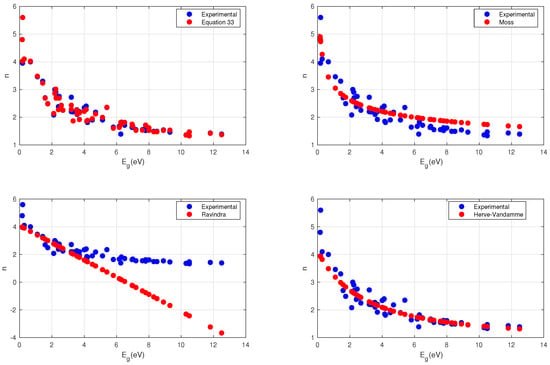
Figure 1
Open AccessArticle
Conversion of Hard to Soft Magnetic Ferrite Nanowires by Paramagnetic Shielding
by
Xian-Lin Zeng, Indujan Sivanesarajah and Uwe Hartmann
Solids 2023, 4(4), 304-315; https://doi.org/10.3390/solids4040019 - 16 Oct 2023
Cited by 1
Abstract
►▼
Show Figures
In this study, we investigate the magnetization behavior of coaxial nanowires fabricated through the sol-gel electrospinning method. Our analysis uncovers a significant reduction in coercivity for CoFe
In this study, we investigate the magnetization behavior of coaxial nanowires fabricated through the sol-gel electrospinning method. Our analysis uncovers a significant reduction in coercivity for CoFe

Figure 1
Open AccessArticle
Evaluating Phonon Characteristics by Varying the Layer and Interfacial Thickness in Novel Carbon-Based Strained-Layer Superlattices
by
Devki N. Talwar and Piotr Becla
Solids 2023, 4(4), 287-303; https://doi.org/10.3390/solids4040018 - 01 Oct 2023
Abstract
Systematic results of lattice dynamical calculations are reported as a function of m and n for the novel (SiC)m/(GeC)n superlattices (SLs) by exploiting a modified linear-chain model and a realistic rigid-ion model (RIM). A bond polarizability method is employed to
[...] Read more.
Systematic results of lattice dynamical calculations are reported as a function of m and n for the novel (SiC)m/(GeC)n superlattices (SLs) by exploiting a modified linear-chain model and a realistic rigid-ion model (RIM). A bond polarizability method is employed to simulate the Raman intensity profiles (RIPs) for both the ideal and graded (SiC)10-Δ/(Si0.5Ge0.5C)Δ/(GeC)10-Δ/(Si0.5Ge0.5C)Δ SLs. We have adopted a virtual-crystal approximation for describing the interfacial layer thickness, Δ (≡0, 1, 2, and 3 monolayers (MLs)) by selecting equal proportions of SiC and GeC layers. Systematic variation of Δ has initiated considerable upward (downward) shifts of GeC-(SiC)-like Raman peaks in the optical phonon frequency regions. Our simulated results of RIPs in SiC/GeC SLs are agreed reasonably well with the recent analyses of Raman scattering data on graded short-period GaN/AlN SLs. Maximum changes in the calculated optical phonons (up to ±~47 cm−1) with Δ = 3, are proven effective for causing accidental degeneracies and instigating localization of atomic displacements at the transition regions of the SLs. Strong Δ-dependent enhancement of Raman intensity features in SiC/GeC are considered valuable for validating the interfacial constituents in other technologically important heterostructures. By incorporating RIM, we have also studied the phonon dispersions [
(This article belongs to the Special Issue A Themed Issue in Honour of Professor Alexandra Navrotsky on the Occasion of Her 80th Birthday)
►▼
Show Figures
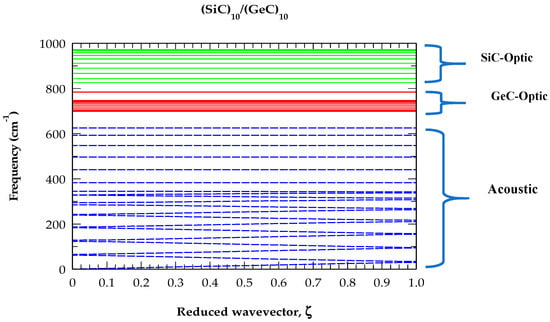
Figure 1
Highly Accessed Articles
Latest Books
E-Mail Alert
News
Topics
Topic in
Energies, Materials, Molecules, Nanomaterials, Solids
Computational Chemistry in Metallurgy, Materials and Energy
Topic Editors: Kejiang Li, Guangyue Li, Qifan ZhongDeadline: 20 October 2024
Topic in
Catalysts, Crystals, Inorganics, Materials, Molecules, Solids
Advances in Inorganic Synthesis
Topic Editors: Andrei V. Shevelkov, Maxim N. SokolovDeadline: 31 December 2024

Conferences
Special Issues
Special Issue in
Solids
A Themed Issue in Honour of Professor Alexandra Navrotsky on the Occasion of Her 80th Birthday
Guest Editor: Sophie Guillemet-FritschDeadline: 30 June 2024
Special Issue in
Solids
Amorphous Materials: Fabrication, Properties, and Applications
Guest Editor: Tao DuDeadline: 31 October 2024
Special Issue in
Solids
Advances in the Study and Application of Polymers
Guest Editors: Vincent Ladmiral, Mona SemsarilarDeadline: 31 December 2024



